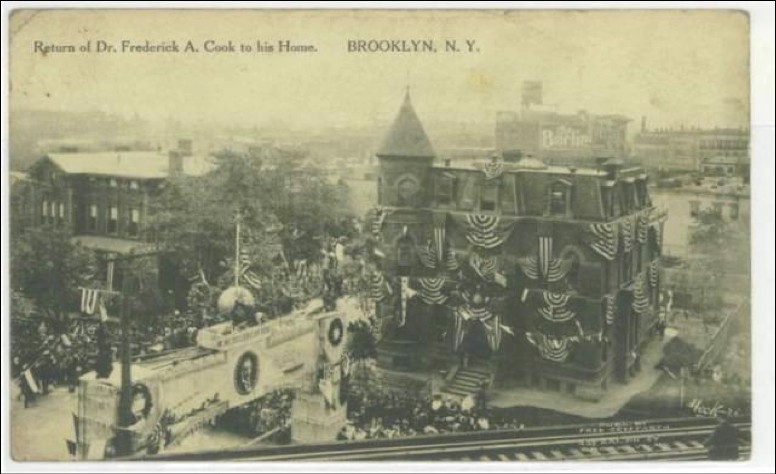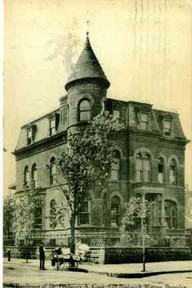The Lipsius-Cook Mansion
Introduction
Text-to-speech Audio
The Lipsius-Cook Mansion, also known as the Catherina Lipsius House and the Dr. Frederick A. Cook House, was originally built for the widowed Catherine Lipsius in 1889. During this time, the widowed Lipsius was running the Claus-Lipsius Brewery. She commissioned the construction of this house on an undeveloped plot of land between Bushwick and Willoughby Avenues. The mansion was designed by Theobald Engelhardt, a Brooklyn-born architect and well-known individual in Brooklyn’s German community that would go on to design a number of other important buildings in the city, such as the William Ulmer Brewery complex and the Eberhard Faber Pencil Company.
The mansion was completed in 1890, and Catherina moved in with her four children. In 1902, the house was sold to Dr. Frederick A. Cook, an arctic explorer that would later claim to have reached the North Pole one year before Robert Peary. In 1920, ownership of the house passed to an Italian, Guiseppe Giambalvo. He occupied the building with his family until 1952, when the property was sold to the local branch of the Daughters of Wisdom – a Roman Catholic Christian organization that moved to New York from France in the early 20th century. The house changed ownership twice more; it was purchased by Dr. Clement Davis in 1960 and by the current owners in 2000.
Images
The house in 1909, when it was owned by Frederick Cook, on the day in which he returned from his alleged trip to the North Pole (wagnerowicz.wordpress.com)

The house as it appeared at the turn of the century (noveltytheater.com)

The house as it appears today, showing the two-storey extension added after ownership passed from Catherina Lipsius (Jeff Reuben, www.flickr.com)

Backstory and Context
Text-to-speech Audio
Following the 1848 revolutions in Europe, thousands of Germans immigrated to New York and settled in Bushwick. With them came the skills and knowledge of German beer brewing, which quickly became the major local industry thanks to the ample water supply in the surrounding land and excellent rail and water connections to the growing labor pools of nearby towns. One of the numerous breweries that emerged in the late 19th century was the Claus Lipsius Brewing Company, located at 471 Bushwick Avenue. Henry Claus founded the company in 1865 but died seven years later. His German widow, Catherina, remarried to Rudolph Lipsius who did much to expand the brewery and added further branches to the enterprise. However, he also died in 1882. Catherina subsequently assumed ownership of the brewery herself and managed the company until her son, Henry, took over.
The house is built in an American round-arched style. The style originated in Germany between the 1820s and 1860s, where it was known as Rundbogenstil and was brought to the USA with the immigrants that left Europe. The red brick house features a three story round tower and an entrance vestibule flanked by round-arched windows. A cast iron cornice crowns the building, above which rises the mansard roof with plastered dormer windows. The incorporation of rough-faced stone moldings gives the building a rustic, medieval appearance that combines well with the classical elements of the architecture. Although a “no-trespassing” sign presently drives away visitors, the building can be admired from almost all angles from the surrounding streets.
The house is built in an American round-arched style. The style originated in Germany between the 1820s and 1860s, where it was known as Rundbogenstil and was brought to the USA with the immigrants that left Europe. The red brick house features a three story round tower and an entrance vestibule flanked by round-arched windows. A cast iron cornice crowns the building, above which rises the mansard roof with plastered dormer windows. The incorporation of rough-faced stone moldings gives the building a rustic, medieval appearance that combines well with the classical elements of the architecture. Although a “no-trespassing” sign presently drives away visitors, the building can be admired from almost all angles from the surrounding streets.
Sources
"Catherina Lipsius House." NYC. 6/25/13. Accessed Web, 6/8/17. http://www.nyc.gov/html/lpc/downloads/pdf/reports/2549.pdf.
"Lipsius House." Novelty Theater. Accessed Web, 6/8/17. http://www.noveltytheater.com/buildings/lipsius-house.
Meier, Allison C. "Brooklyn History: A Tale of Two Explorers." Brooklyn Based. 12/4/12. Accessed Web, 6/8/17. https://brooklynbased.com/blog/2012/12/04/brooklyn-history-a-tale-of-two-explorers/.
Mackay, Alistair. "The True Story of Mr. and Mrs. Claus, the North Pole and Brooklyn Beer." Bedford and Bowery. 12/24/13. Accessed Web, 6/8/17. http://bedfordandbowery.com/2013/12/the-true-story-of-mr-and-mrs-claus-the-north-pole-and-brooklyn-beer/.
"Lipsius House." Novelty Theater. Accessed Web, 6/8/17. http://www.noveltytheater.com/buildings/lipsius-house.
Meier, Allison C. "Brooklyn History: A Tale of Two Explorers." Brooklyn Based. 12/4/12. Accessed Web, 6/8/17. https://brooklynbased.com/blog/2012/12/04/brooklyn-history-a-tale-of-two-explorers/.
Mackay, Alistair. "The True Story of Mr. and Mrs. Claus, the North Pole and Brooklyn Beer." Bedford and Bowery. 12/24/13. Accessed Web, 6/8/17. http://bedfordandbowery.com/2013/12/the-true-story-of-mr-and-mrs-claus-the-north-pole-and-brooklyn-beer/.
